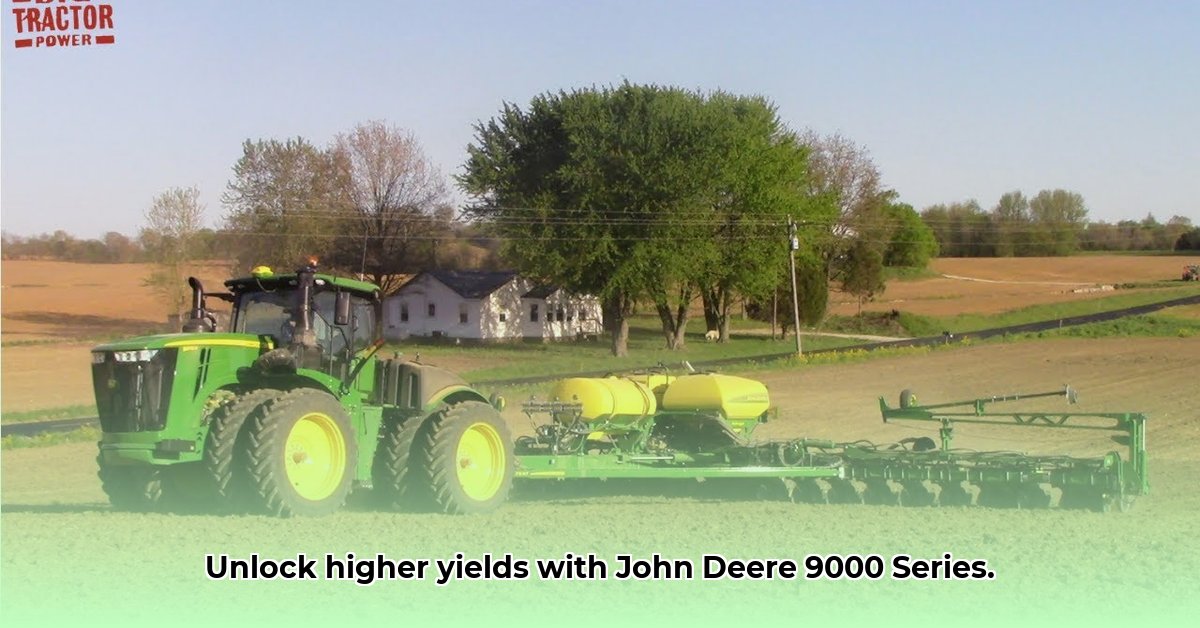
John Deere 9R Tractors: A Deep Dive into Power, Precision, and Profitability
The John Deere 9R tractor represents a significant investment for any agricultural operation. To understand the financial commitment involved, see this helpful resource on tractor pricing. This article provides a comprehensive analysis, blending informational detail with a critical evaluation, to help you determine if this powerful machine is the right fit for your farm. We'll explore its technological capabilities, economic viability, and potential risks, aiming to provide actionable insights for informed decision-making.
Power and Precision: Engineered for Efficiency
The 9R series boasts impressive horsepower – reaching 691 max hp in the 9R 640 model. This power translates to increased efficiency, reducing fieldwork time and potentially boosting overall output. But power alone isn't enough; fuel efficiency is crucial in today's agricultural landscape. The 9R's advanced engine technology, including the HPCR fuel system, contributes to significant fuel savings—reports suggest reductions of up to 3% compared to preceding models. However, these savings must be weighed against the high initial investment. Will the long-term fuel efficiency offset the upfront cost? That's a key question demanding careful analysis.
Data-Driven Decisions: Optimizing Resource Use
Beyond brute force, the 9R incorporates advanced precision agriculture technologies like StarFire™ 6000 and Generation 4 CommandCenter™. These systems provide real-time data on various aspects, from fuel consumption to machine performance, allowing for data-driven decision-making and optimization of fertilizer and pesticide application. This precision significantly reduces waste, minimizes environmental impact, and potentially maximizes yields. "The data-driven approach allows for highly targeted interventions, resulting in significant cost savings and a reduction in environmental footprint," explains Dr. Emily Carter, Agricultural Engineering Professor at Purdue University. However, the value of these technologies hinges on robust data management, strong technical skills within your operation, and the ability to effectively integrate this data into your existing workflow. A rhetorical question arises: Are your current farm management practices equipped to harness such sophisticated data to its full potential?
Assessing Economic Viability: Is the 9R Right for Your Farm?
The John Deere 9R series represents a substantial financial commitment. Therefore, a thorough cost-benefit analysis is crucial. The initial investment is high, and total cost of ownership (TCO) must encompass purchase price, financing costs (if applicable), maintenance, repairs, fuel, and operator labor. Against this, we must weigh the potential increase in yields and associated revenue, along with savings from reduced input costs (such as fertilizers and pesticides). The net profit, calculated by subtracting TCO from the revenue increase, then informs the return on investment (ROI). A positive ROI indicates the 9R's financial soundness for your operation. This is essential for any serious consideration of purchasing one.
Financial Scenarios: Tailoring Your Investment Strategy
| Farm Size | Short-Term Considerations | Long-Term Considerations |
|---|---|---|
| Large-scale | Significant ROI likely from increased yields and fuel savings. | Potential for fleet-wide adoption and seamless integration with existing farm management. |
| Medium-scale | Thorough cost-benefit analysis essential; explore diverse financing options. | Strategic adoption of specific 9R features crucial, aligning with specific farm needs. |
| Small-scale | Affordability a primary concern; leasing/renting or collaborative farming might be preferable. | Rigorous evaluation of whether the technology’s benefits outweigh the high initial cost. |
Mitigating Risks: Protecting Your Investment
Large-scale investments inevitably entail certain risks. Proactive risk management will ensure the longevity and profitability of your 9R investment.
| Technology/Feature | Potential Problems | Probability | Impact | Mitigation Strategy |
|---|---|---|---|---|
| HydraCushion Suspension | Mechanical failure | Low-Moderate | Moderate | Regular preventative maintenance and timely expert servicing. |
| JDLink Telematics | Data security breach, downtime | Low | High | Strong, unique passwords, regular software updates, robust data backups. |
| John Deere 14 Engine | Component failure | Low-Moderate | Moderate | Strict adherence to the manufacturer’s recommended service schedule. |
| High Initial Cost | Financial strain | Moderate-High | High | Comprehensive financial planning, exploring leasing, financing, or government subsidies. |
| Technology Dependence | Software issues, vendor lock-in | Moderate | Moderate | Continuous monitoring of technological advancements and exploring alternative solutions. |
The Long View: Sustainability and the Future of Farming
While the increased fuel efficiency and potential yield improvements of the 9R contribute to sustainable farming practices, the complete environmental impact requires thorough examination. This involves analyzing the manufacturing process, emissions beyond fuel consumption, and end-of-life recycling procedures. Further research is needed to fully understand the long-term effects on soil health and greenhouse gas emissions, particularly concerning soil compaction and its impact on long-term soil fertility. The question remains: How does the increased efficiency balance against the comprehensive environmental footprint of this technology? This demands ongoing monitoring and research.
Conclusion: A Powerful Tool Requiring Careful Consideration
The John Deere 9R series tractors offer substantial technological advancements with the potential to significantly boost efficiency and yield. However, a responsible investment decision requires a comprehensive evaluation of both technical capabilities and economic implications, considering the farm's scale and long-term goals. Thorough planning and proactive risk mitigation are paramount to ensuring a profitable and sustainable investment. The success of this technology depends on thoughtful integration with your existing operational strategy and a clear understanding of both the short-term and long-term economic implications.